Technology
Congratulations; you&ve decided to launch a technology-enabled startup with a positive social impact! Nearly every major Silicon Valley venture-capital firm has now invested in a B Corp; maybe you will be one of them!
The bad news: some venture capitalists have a bias against startups with an explicit positive social impact on the grounds that they have a smaller addressable market, and that the founders are not sufficiently focused on creating shareholder wealth. And of course, effectively all venture capitalists are going to require some equity for their investment.
Fortunately, there are a wide range of organizations that specifically want to support you, not just the VC community. I&m now researching non-dilutive funding for Action Tank, a startup I&m gestating to &Make America Functional Again.& I worked with outsourced research firm Wonder* to identify all of the institutions we could who support tech impact startups with cash and community, and in many cases without dilution. I emphasize my focus here is organizations which are backing for-profit companies and do not take equity. If you think I&ve missed any, please contact me.
I suggest start by looking at the many programs offered by the Fortune 500startup networks. In addition, there are many other groups will give you cash, training, and community with few or no strings attached:
Ashoka is a foundation that engages in scouring for and choosing the leading social entrepreneurs across the globe, who it refers to as Ashoka Fellows.
Aspen Tech Policy Hub. &Our program mixes the best of both Washington and Silicon Valley, bringing together stakeholders in policy and technology to train the next generation of policy entrepreneurs. The Aspen Tech Policy Hub is a West Coast policy incubator, training a new generation of tech policy entrepreneurs. We take tech experts, teach them the policy process through an in-residence fellowship program in the Bay Area, and encourage them to develop outside-the-box solutions to societyproblems. We model ourselves after tech incubators like Y Combinator, but train new policy thinkers and focus the impact of their ideas.
Bluhm/Helfand Social Innovation (BHSI) Fellowship. &Since 2011, the Bluhm/Helfand Social Innovation (BHSI) Fellowship has supported the work of 36 innovators—representing the United States as well as 18 other countries on five continents—who address pressing global issues, from healthcare delivery to college persistence and sustainable construction in developing nations. From the beginning, the BHSI Fellowship has created meaningful, customized experiences for Fellows with connections to influential business and civic leaders, exposure to a broad audience as a speaker at Chicago Ideas, and over $3 million in financial support and in-kind contributions.&
The Clayton, Dubilier - Rice Fund for Entrepreneurial Studies. &The Clayton, Dubilier - Rice Fund for Entrepreneurial Studies supports entrepreneurs attempting to build something that advances business and society in revolutionary ways. &
Columbia Business School Tamer Fund for Social Ventures. Requires Columbia affiliation.
Draper Richards Kaplan Foundation identifies entrepreneurs that display characteristics of &exceptional social leadership through discretion, influence, vision, ambition, intelligence, and follow-through.&
DV Hacks, led by BCG Digital Ventures: &A 48-hour hackathon to improve how we live, work, collaborate, and learn.&
Echoing Green is a foundation that distinguishes transformational leaders via its fellowships. Their foci include addressing environmental sustainability, racial and gender equity, economic development concerns, etc.
Future Labs Flash Pitch. &For pre-seed and seed companies based in the U.S. and Israel with a focus on AI for social impact,&
Google AI for Social Good. &Our 20 selected organizations will receive coaching from GoogleAI experts, Google.org grant funding from a $25 million pool, and credits and consulting from Google Cloud. They will also be offered the opportunity to join a customized 6-month Google Developers Launchpad Accelerator program, including guidance from our nonprofit partner, DataKind, to jumpstart their work. We looked for projects across a range of social impact domains and levels of technical expertise, from organizations that are experienced in AI to those with an idea for how they could put their data to better use. &
Google for Startups Accelerator. &Geared toward social impact startups working to create a healthier and more sustainable future, the accelerator provides access to training, products and technical support. Startup founders will work with Google engineers and receive mentoring from over 20 teams at Google, as well as outside experts and local mentors.
J.M.Kaplan Innovation Prize. &The J.M.K. Innovation Prize seeks out innovators who are spearheading transformative early-stage projects in the fields of the environment, heritage conservation, and social justice. The J.M.K. Innovation Prize is open to nonprofit and mission-driven for-profit organizations that are tackling Americamost pressing challenges through social innovation. In 2019, we will award up to ten prizes, each including a cash award of $150,000 over three years, plus $25,000 for project expenses, for a total award of $175,000.
Kairos Fellows. &The Kairos Fellowship is designed to build the next generation of leaders in the field of technology, analytics, digital campaigning, and online organizing.&
MIT Solve initiative. &MIT Solve advances lasting solutions from tech entrepreneurs to address the worldmost pressing problems. Solve is a marketplace for social impact: we find tech entrepreneurs from around the world and broker partnerships across our community to scale their innovative work — driving lasting, transformational change.&
Mulago Foundation Rainer Arnhold Fellowship. &The course brings Fellows and faculty together for an intensive week to work on design for maximum impact and scalability. Held in a retreat center on the coast in Bolinas, California, the course gives Fellows the rare opportunity to focus completely on their ideas and a systematic way to apply them.&
Bloomberg New Economy Forum Solutions. &Mike Bloomberg announces an open call for solutions to global challenges facing the new economy. Entrepreneurs, academics, founders, and big thinkers are invited to submit their solutions to societal problems that need momentum, support, and adoption from the private sector.&
Notley Ventures. &Notley is a catalyst for social innovation unlocking opportunities with todayimpact organizations and changing communities. Our mission is to scale and support businesses, nonprofits, individuals, and programs making positive change in the world.&
Recurse Center. &The Recurse Center is a self-directed, community-driven educational retreat for people who want to get better at programming.&
Skoll Foundation. &The Skoll Foundation drives large-scale change by investing in, connecting, and celebrating social entrepreneurs and innovators who help them solve the worldmost pressing problems.&
Summit Fellows. &Through a series of invitation-only events, Summit fosters a global community of entrepreneurs, academics, athletes, artists, astronauts, authors, chefs, engineers, explorers, philanthropists, spiritual leaders, scientists, and beyond.&
Thiel Fellowship. &Founded by technology entrepreneur and investor Peter Thiel in 2011, the Thiel Fellowship is a two-year program for young people [under 22] who want to build new things. Thiel Fellows skip or stop out of college to receive a $100,000 grant and support from the Thiel Foundationnetwork of founders, investors, and scientists.&
Pioneer.app. &Get funding and guidance for your project. Pioneer is a weekly contest for creative people around the world making their ideas become real. Winners get $7000, a round-trip ticket to Silicon Valley, access to world-class mentorship, and more.&
Roddenberry Foundation Catalyst Fund. &The Catalyst Fund awards small grants for early-stage, innovative, and unconventional ideas that address serious global challenges.&
SEIF Awards Tech for Impact. The SEIF Awards target European impact entrepreneurs who develop or make innovative use of technologies to tackle social and/or environmental challenges and contribute to the UN SDGs [Sustainable Development Goals]. Each Award grants the winners CHF 10&000. Together with our partners UBS and PwC we provide finalists a unique opportunity to increase their international awareness, gain reputation and present themselves to a top-class jury.
Three dot dash. &Powers the most influential social entrepreneurs between the ages of 13 -19, who have found a solution or innovation to address a basic human need.&
YC120 (part of Y Combinator). &We&d like to find more curious, creative people who are doing exciting work in emerging fields and give them an opportunity to start building their network. &
VentureCrush FG. Pando Daily wrote: &VentureCrushFG takes no equity, there is no co-working space, and no demo day. The application process is not advertised. Most applicants come from referrals.& &VentureCrushFG[‘s]…stellar reputation among founders and investors is due, in part, to the success of its most high-flying companies.& &If anything, itmore of a community than an accelerator, a way to keep a strong network of alumni, mentors and investors connected. Between one and two hundred techies are part of the group, including founders, execs, 40 to 50 VCs and a few dozen angel investors.&&
We Company Creator Awards. &This global competition is open to entrepreneurs, performers, startups, and nonprofits-anyone who embodies our mantra, Create Your LifeWork.&
World Summit Awards for Young Innovators. &WSA Young Innovators is a special recognition for young social entrepreneurs under 30 years of age, using ICTs to take action on the United Nations Sustainable Development Goals (UN SDGs). Together with the WSA winners of each year, they are honored as outstanding digital innovation with social impact.&
You may also want to look at product-based crowdfunding, e.g., Indiegogo*. Other traditional options for non-dilutive financing include grants, loans, SBIR, STTR, vouchers and tax credits, include:
- WonderOverview of Non-Dilutive Funding
- Non-Dilutive Financing: Everything You Need to Know
- Beyond the SBIR: Non-Dilutive Funding for Your Startup
- National Economic Impacts from the DOD SBIR/STTR Program
You&re eligible for the many accelerators, as well as specifically the impact accelerators. See Conveners Impact Accelerator Selection Tool. Some specific accelerators:
- 17 Incubators For Impact Entrepreneurs and Social Enterprise
- Blue Ridge Labs @ Robin Hood
- Higher Ground Labs
- Catalyst Fund (Managed by BFA, founded in 2016 with support of the Bill - Melinda Gates Foundation and JPMorgan Chase - Co)
- Techstars Impact Accelerator
- Y Combinator
There are many VCs who have a stated focus on social impact; for full lists see Impact Capital Managers and InvestorFlow. Oliver Libby, Managing Partner, H/L Ventures, notes, &it is important to remember that impact funders occupy the same spectrum of returns as regular investors. From 100% loss capital (e.g. a grant) to shooting for massive returns (some impact VCs), an entrepreneur can unlock everything in between, including first-loss capital, impact bonds, patient capital from program-related investments and families, and more. The market is also coming to understand that high impact can sometimes come with high returns too.&
Rachel Butler, President, Cavendish Impact Foundation (where I&m an advisor), mentioned fiscal sponsorship as an option. &Itan arrangement where an entity in need of funding (and it can be a for-profit, social enterprise) teams up with a 501(c)(3) that has an aligned mission, and money can be raised through the 501(c)(3) and used to support a specific project being done by the social enterprise.
So, for example, if the 501(c)(3) has in its mission to support improving education, and a for-profit social enterprise is developing an app to help improve access to better education for people in underserved communities, the 501(c)(3) could support that specific project. The 501(c)(3) does have to maintain discretion about how they use the funds (as a safeguard to just having it be an arrangement for funneling philanthropic funds), and there are some other stipulations, but otherwise itpretty straightforward. The ‘Project& can actually do the fundraising, as an agent of the 501(c)(3), and have the money directed to the 501(c)(3). The project is usually something that has a fairly short timeframe with measurable milestones that indicate progress. The 501(c)(3) also takes an administrative fee for their role in the collaboration.&
Bill Warren, CEO of Peeps Democracy, Inc., wrote, &another type of funding source for a social impact entrepreneur to think about is startup challenges/competitions at her/his alma mater. For example, Duke sponsors a $10,000 annual prize for students, faculty, or alumni working on a startup in the clean energy space. These prizes can be a great source of non-dilutive funding for early-stage ventures and also offer free exposure to academic thought-leaders and other alumni, who might support your startup via mentorship or investment. &
Emily Rasmussen, founder - CEO of Grapevine.org, suggests turning philanthropic donations into for-profit investments using Donor Advised Funds (DAFs), which are like Health Savings Accounts for charitable giving. You make a tax deductible donation into a DAF account, get an immediate tax deduction, and then donate your funds out to charities over time. In the meantime, your funds are invested to help grow your fund, just like an endowment. With some 501(c)(3) DAF sponsors (e.g Impact Assets), after making a tax-deductible donation into their DAF account, donors can then advise the sponsor to invest their charitable assets into a specific social enterprise deal. These deals are sourced by the donor investor and any future returns go back into the DAF account and are available for future impact investments or charitable donations.
Lastly, I suggest reviewing these links on fundraising:
- Please don&t pitch a venture capitalist without this checklist
- What type of capital should you raise, and from who?
- How Tech Startups Can Get Money and Support from the Fortune 500
- Fundraising Hacks: How to Raise Capital for your Startup
- How Star Wars will help you raise capital for your company
- Face-to-face meetings are important, but written collateral is mandatory for closing the deal
- The investment committee rejected you; what does that actually mean?
- Is Venture Capital Right for Social Ventures?
* I&m an investor in this company.
Thanks to Emily Campbell, Esq., of The Campbell Firm PLLC for helpful input; she has advised me on some legal matters in the past.
- Details
- Category: Technology
Read more: Finding free money for your social impact startup
Write comment (93 Comments)Facebook is expanding Crisis Response, its disaster-reporting and communications feature thatbeen used in 300 crises in more than 80 countries. The company today is announcing several new features, including WhatsApp integration, support for first-hand information sharing and an expansion of its &Data for Good& tools for things like better disaster and displacement maps.
Crisis Response originally grew out of a handful of features that help family, friends and communities support one another in the wake of a disaster. A couple of years ago, Facebook organized these tools — like Safety Check, Community Help and Fundraisers — all under a centralized &Crisis Response& centralized hub.
Today, Facebook is adding new functionality to Crisis Response which will allow people in affected areas to share first-hand information about what they&re witnessing or think others should know — like building collapses or road closures, for example. This is in addition to their existing ability to share requests or offers for help, as before.
In addition, Facebook Crisis Response now works with WhatsApp . This particular integration is fairly light — the entire feature set isn&t coming to WhatsApp, to be clear. But people can now offer or request help through the messaging app, instead of using just Facebook Messenger.
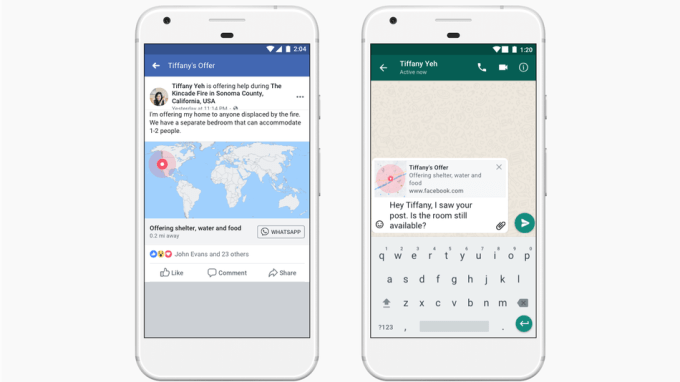
Facebook&Data for Good& tools are also being updated and expanded. Via partnerships with more than 100 organizations, Facebook provides disaster maps and relief organizations with information about where to distribute supplies, based on aggregated, anonymized data.
With the updates, Facebook says itnow able to deliver these updates to state and local officials, as well as federal relief agencies, thanks to partnerships with organizations like Direct Relief and the National Alliance for Public Safety GIS (NAPSG) Foundation.
The company is also improving its disaster maps, following its work with experts on the topic of displacement, like the International Displacement Monitoring Centre. The maps have been corrected for things like commute patterns and tourist populations, Facebook says.
The new features are rolling out now.
- Details
- Category: Technology
Read more: Facebook updates crisis response tools, adds WhatsApp integration
Write comment (90 Comments)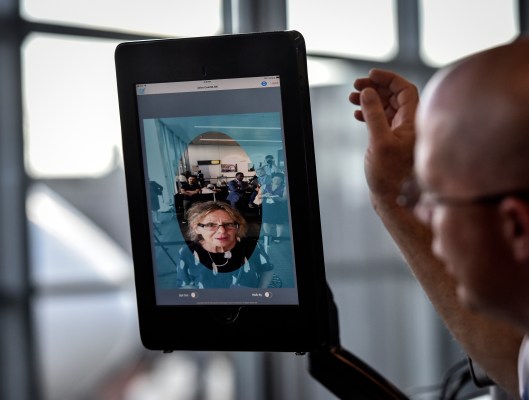
Homeland Security wants to expand facial recognition checks for travelers arriving to and departing from the U.S. to also include citizens, which had previously been exempt from the mandatory checks.
In a filing, the department has proposed that all travelers, and not just foreign nationals or visitors, will have to complete a facial recognition check before they are allowed to enter the U.S., but also to leave the country.
Facial recognition for departing flights has increased in recent years as part of Homeland Securityefforts to catch visitors and travelers who overstay their visas. The department, whose responsibility is to protect the border and control immigration, has a deadline of 2021 to roll out facial recognition scanners to the largest 20 airports in the United States, despite facing a rash of technical challenges.
But although there may not always be a clear way to opt-out of facial recognition at the airport, U.S. citizens and lawful permanent residents — also known as green card holders — have been exempt from these checks, the existing rules say.
Now, the proposed rule change to include citizens has drawn ire from one of the largest civil liberties groups in the country.
&Time and again, the government told the public and members of Congress that U.S. citizens would not be required to submit to this intrusive surveillance technology as a condition of traveling,& said Jay Stanley, a senior policy analyst at the American Civil Liberties Union .
&This new notice suggests that the government is reneging on what was already an insufficient promise,& he said.
&Travelers, including U.S. citizens, should not have to submit to invasive biometric scans simply as a condition of exercising their constitutional right to travel. The governmentinsistence on hurtling forward with a large-scale deployment of this powerful surveillance technology raises profound privacy concerns,& he said.
Citing a data breach of close to 100,000 license plate and traveler images in June, as well as concerns about a lack of sufficient safeguards to protect the data, Stanley said the government &cannot be trusted& with this technology and that lawmakers should intervene.
When reached, spokespeople for Homeland Security and Customs - Border Protection did not immediately have comment.
- Details
- Category: Technology
Read more: DHS wants to expand airport face recognition scans to include US citizens
Write comment (99 Comments)A few weeks ago, Ubiquiti unveiled the UniFi Dream Machine, an all-in-one networking device that for $299 combines a router, a switch with four Ethernet ports and a Wi-Fi access point. It has what Ubiquiti calls an integrated cloud key that lets you control your network.
I&ve been using the UniFi Dream Machine on my home network for the past couple of weeks, so consider this a review of the device.
Ubiquiti is a well-known networking brand. Most people are familiar with the companyaccess points — those rounded antennas that you can find around schools, companies and public spaces.
But the upfront investment has always been a bit steep for personal use cases and even small companies. The UniFi Dream Machine sits perfectly in between professional gear and consumer devices. It represents a huge upgrade if you&re using the router with Wi-Fi capabilities provided by your internet service provider.
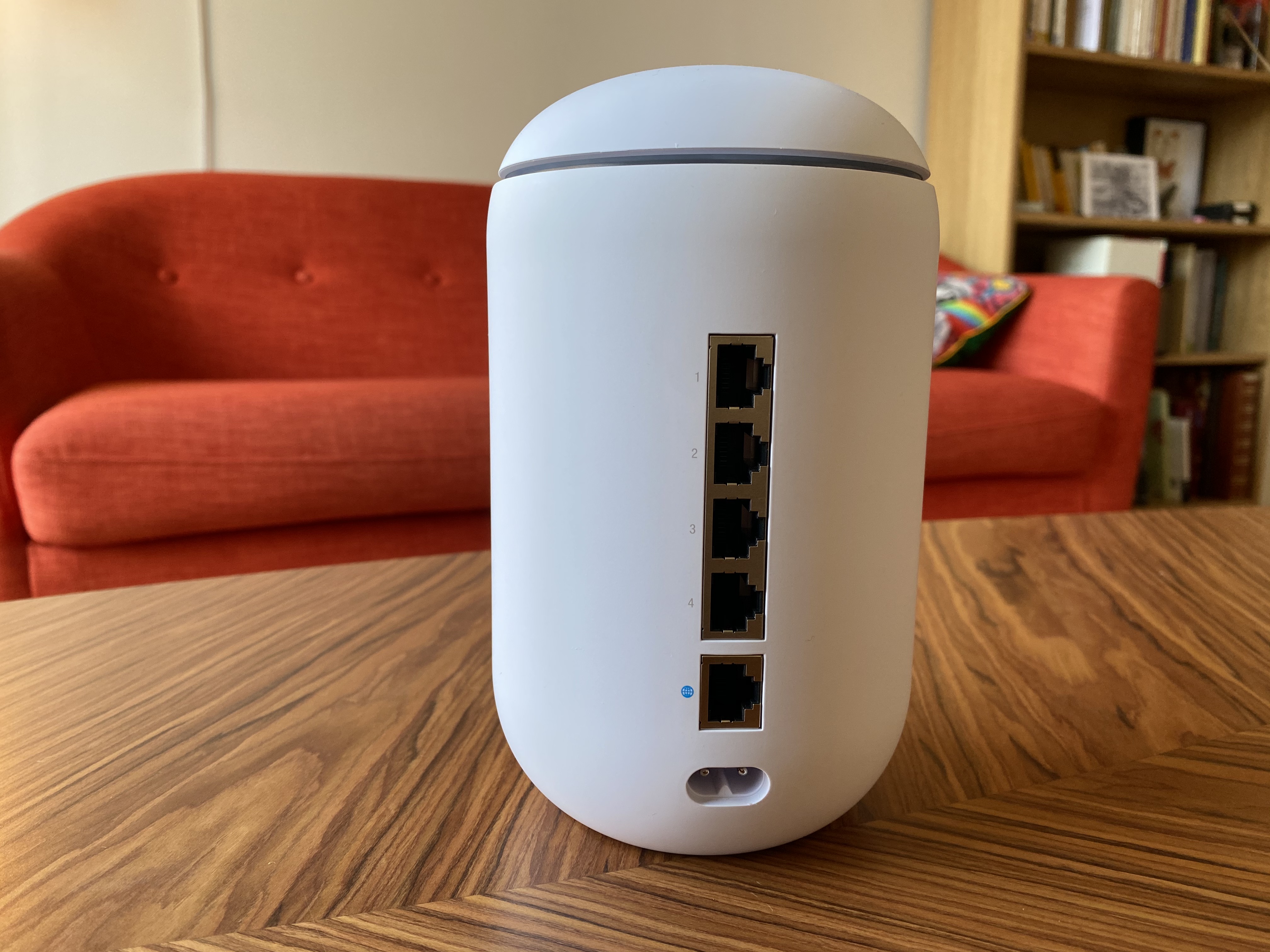
Rebundling UniFi devices
Ubiquiti has a range of routers under the AmpliFi brand for consumers who are looking for a plug-and-play solution. The company recently announced a new device with great specifications if you don&t want to mess around with networking settings.
But if you&re reading this, chances are you know that UniFi products offer some customizations that you think are lacking in consumer products.
Switching from an all-in-one networking device to a UniFi system has always been a bit complicated. The company has broken down the networking stack into different devices to offer you more control.
It means that you have to buy a Security Gateway (a router, the &brain& of the network), a switch (just like a power strip, but for Ethernet ports) and an access point (a Wi-Fi antenna). On top of that, a UniFi cloud key is an essential buy if you want to manage your network with the companycontroller software.
If you&re committed to the UniFi ecosystem, you get a great experience. You can manage each Ethernet port on your switch individually, you can control Wi-Fi settings from anywhere in the world and many, many more things. Ars TechnicaLee Hutchinson fell down the UniFi rabbit hole and wrote a great story about his experience running professional networking gear at home.
The UniFi Dream Machine takes a different approach. It rebundles all the separate pieces that make a UniFi network come to life. You can buy the $300 UniFi Dream Machine and control every little detail of your network.
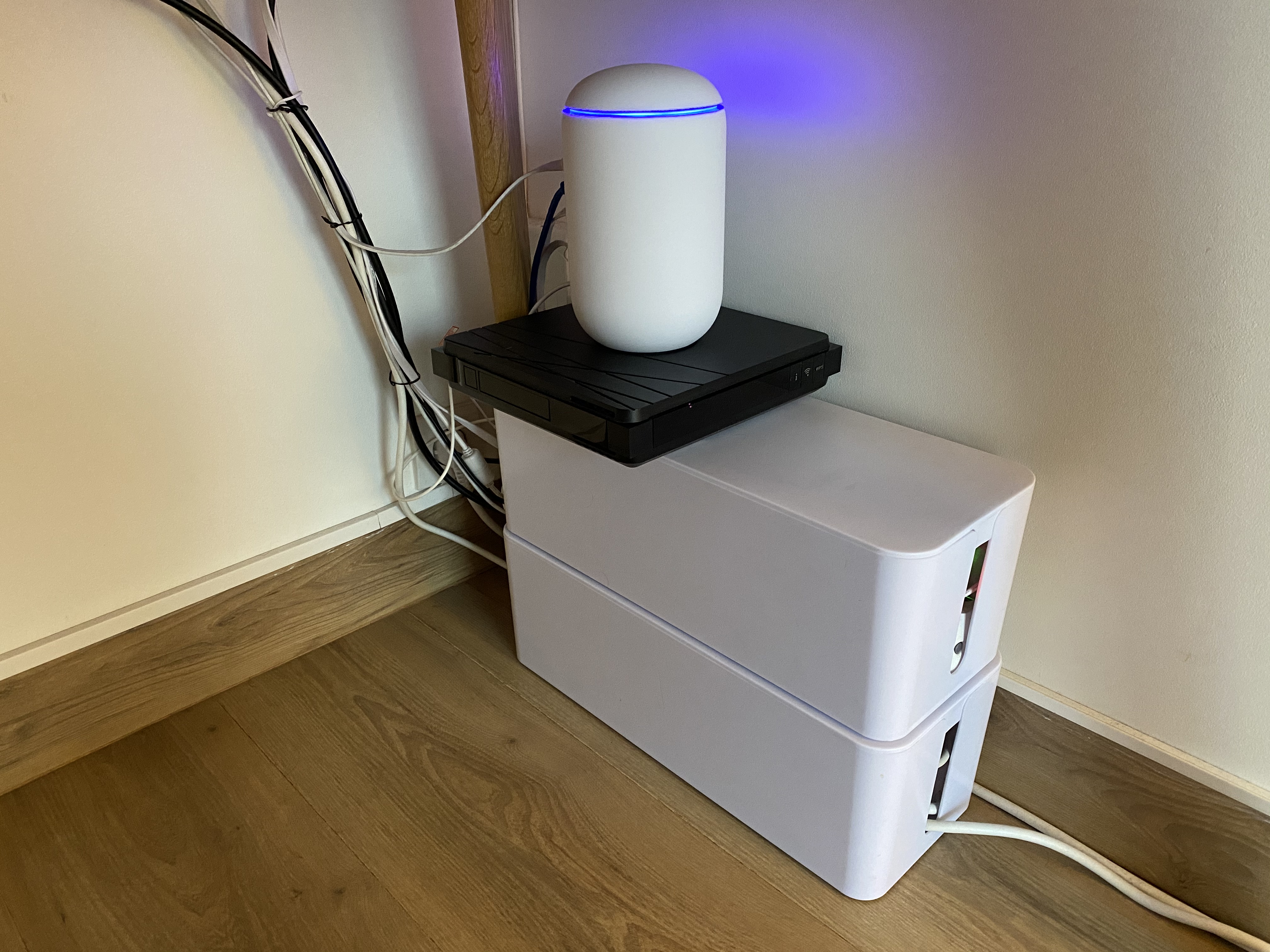
Specifications
A few words on the specifications of the UniFi Dream Machine. The pill-shaped device has an integrated security gateway, which lets you run a DHCP server, create firewall policies, take advantage of multiple VLANs and more.
In addition to the WAN port to connect your device to the internet, there are four Gigabit Ethernet ports. As for Wi-Fi, the Dream Machine supports 802.11ac Wave 2 (&Wi-Fi 5&) with a 4×4 MU-MIMO antenna — no Wi-Fi 6, unfortunately.
Behind the scene, the device uses a 1.7GHz ARM Cortex-A57 processor. It has 2GB of RAM and 16GB of storage and consumes up to 26W.
Using the Dream Machine
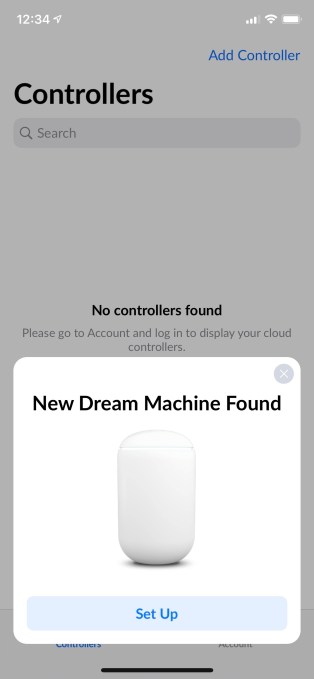
Setting up the UniFi Dream Machine is a great experience. Ideally, you want to plug an Ethernet cable in your ISP-provided router and put it in bridge mode. This way, it&ll act as a dumb modem and let the UniFi Dream Machine do all the hard work.
After downloading the mobile app and turning on the UniFi Dream Machine, you get a popup that mimics the pairing popup of the AirPods. You can then control your network from that mobile app or use a web browser on your computer.
This is when it gets interesting.
UniFicontroller software usually lists all the UniFi devices currently running on your network. With the UniFi Dream Machine, you get a single device. But if you expand that device, you can see a list of three separate UniFi components —a gateway, a switch and an AP.
As expected, you can control every little detail of your network. Once again, this isn&t for everyone and you will have to learn a lot of things about networking in order to optimize your setup. But if you&re a digital tinkerer, ita breath of fresh air.
The UniFi Dream Machine acts as the DHCP server in my home. I have renamed my devices and assigned fixed IPs to all my devices in order to find them more easily. You can see in real time the network they&re using and if they&re getting a good Wi-Fi signal.
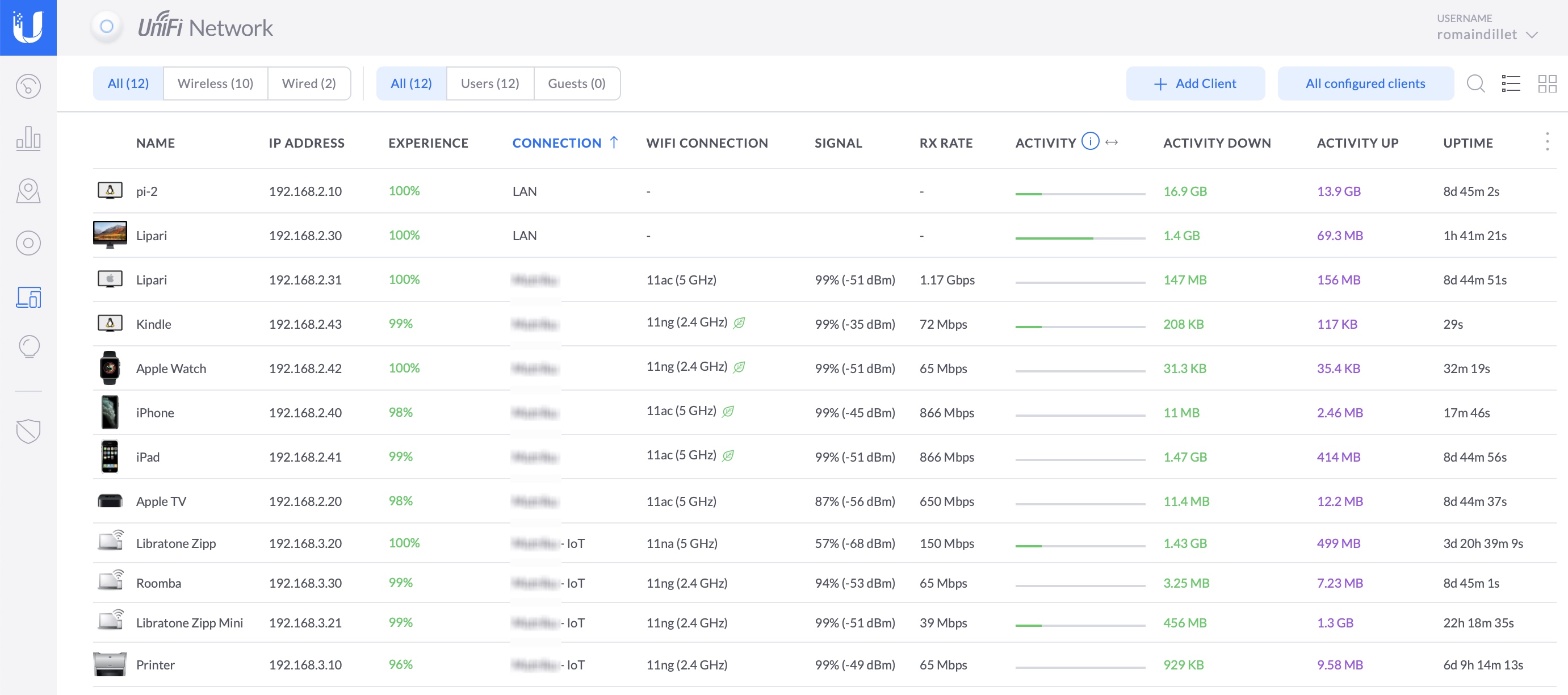
I have also configured Cloudflare1.1.1.1 public DNS at the network level.
There are a ton of possibilities if you care about security. I created a guest Wi-Fi network that only lets my friends access the internet. They can browse Twitter and stream Netflix shows without any issue, but they can&t access my computers on the local network.
I also created another Wi-Fi network for IoT devices, such as connected speakers, a printer and a robot vacuum. Connected devices don&t get a lot of security patches and have more vulnerabilities than a computer or a smartphone that you keep up-to-date. I assigned a different VLAN to this Wi-Fi network. VLANs let you create a partitioned network with different sets of rules.
I applied firewall rules to this VLAN so that I can control the devices from my personal devices, but they can&t initiate requests to my devices on their own. This is overkill for most people, but itfun that you can do that from UniFicontroller. More details here.
When it comes to Wi-Fi, everything is customizable and performances have been stellar. I live in a small apartment, but the balcony has always been an issue. I often work from the balcony, and I&ve been using a cheap Wi-Fi extender that I found in a box of gadgets and cables.
I unplugged the Wi-Fi extender and tried to connect to the UniFi Dream Machine. I get better performance, even if I reduce Wi-Fi transmit power to medium.
These are just a few examples of things you can do with the UniFi Dream Machine. I feel like I&m still underusing the device (you can connect via SSH and control everything from the terminal), but I wouldn&t consider going back to an entry-level router with Wi-Fi capabilities.
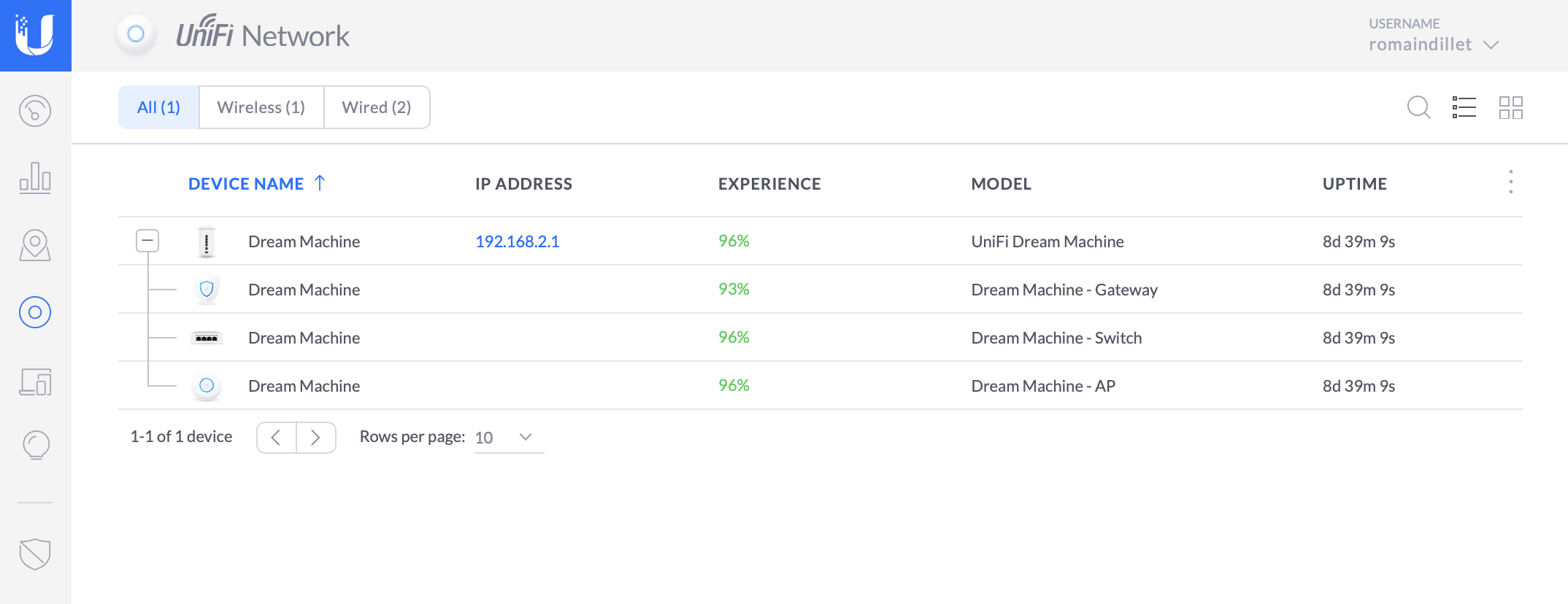
Targeting prosumers
The UniFi Dream Machine is the networking device I didn&t know I wanted. I&ll never have hundreds of Wi-Fi devices connected to my home network. I don&t need a dozen Ethernet ports. And yet, I want to be in control of my network. If you miss AppleAirPort Extreme or if you&re a networking nerd, you should consider the UniFi Dream Machine.
Small businesses and shops often make some poor decisions at the beginning of the company. A cheap Wi-Fi router on Amazon doesn&t cut it when your business scales. The Dream Machine can be a good entry point, as you&ll be able to build upon that base device.
But if you think you have bigger needs, don&t try to run a big network from a UniFi Dream Machine. Ubiquiti sells some great rackable devices that will give you a lot more flexibility. The UniFi Dream Machine is a constrained machine after all. Thatwhat makes it both not good enough for enterprise customers and great for prosumers.
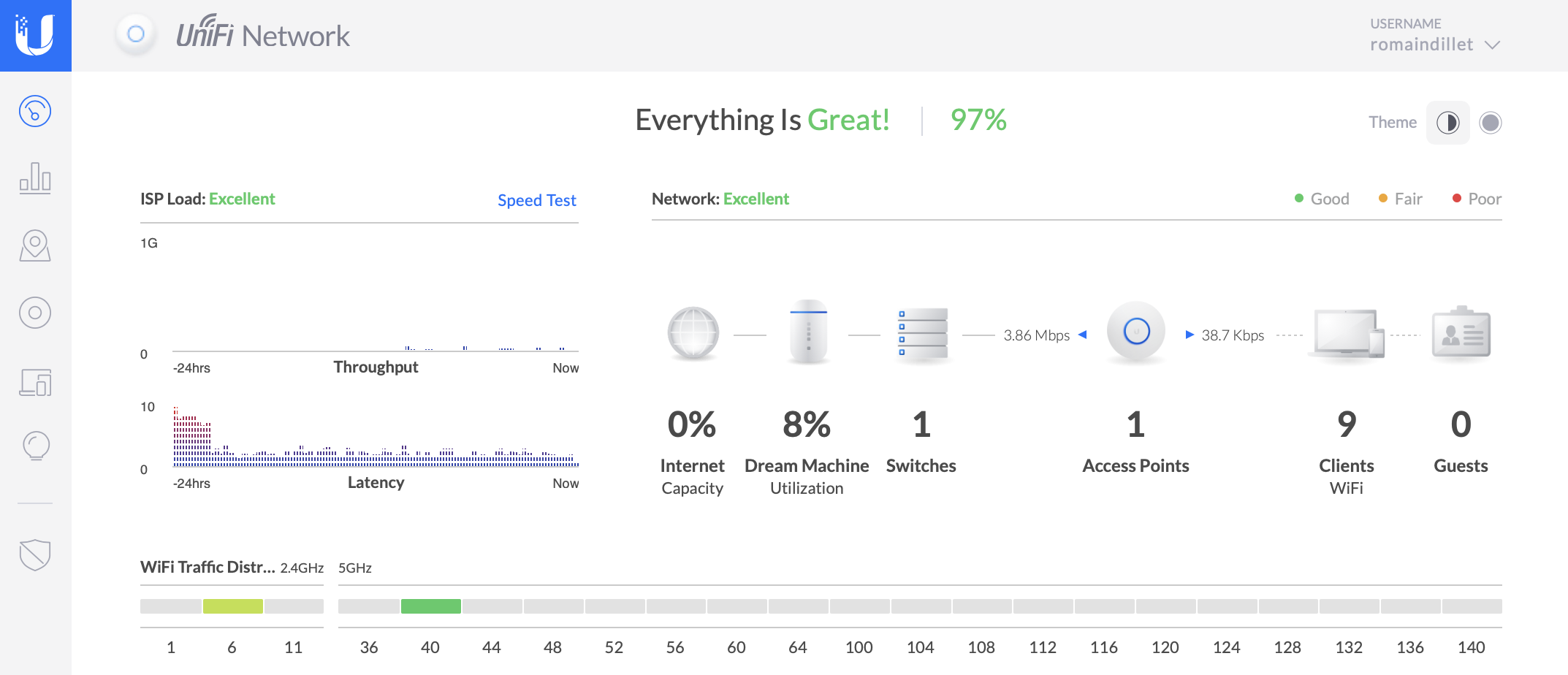
- Details
- Category: Technology
Read more: The UniFi Dream Machine router is a great entry point for networking nerds
Write comment (97 Comments)The Daily Crunch is TechCrunchroundup of our biggest and most important stories. If you&d like to get this delivered to your inbox every day at around 9am Pacific, you can subscribe here.
1. Facebook launches a photo portability tool, starting in Ireland
Facebook says it will make it easier for users to get their photos off the social network and onto another service — a step toward addressing the concerns of lawmakers and antitrust regulators.
The company is starting off with a way for users in Ireland to move pictures into Google Photos via encrypted transfer, but it says the feature will be available worldwide in the first half of 2020 and will eventually include integrations with additional services.
2. In &60 Minutes& appearance, YouTubeCEO offers a master class in moral equivalency
YouTubeSusan Wojcicki told &60 Minutes& reporter Lesley Stahl that the company has drawn a line at taking down videos that cause &harm,& as opposed to videos that might spread merely hatred and disinformation. In response, Connie Loizos argues that the distinction is, in a word, laughable.
3. Ikea is helping to redesign simulated Mars habitats
Ikea has been working with an Earth-based research facility that is meant to mimic what a Mars habitat would be like. Originally, Ikea sent a designer to the station to seek inspiration for creating functional furniture for small apartments — but it quickly became a two-way street, which could mean the Swedish home furnishing company has a say in how future human colonists live on other planets.
4. Accel closes new $550M fund for India
This is a significant amount of capital for Accelefforts in the country, where it began investing 15 years ago and has deployed roughly $1 billion through all its previous funds.
5. Herethe math behind Tesladumb Cybertruck vs F-150 tow test
During the unveiling of the Cybertruck, Tesla included a butt-to-butt pull-off. Besides being a silly test, this particular demo was flawed in multiple ways, giving the Tesla a major advantage.
6. Will the future of work be ethical? Founder perspectives
Following up on Greg Epsteincolumn about whether the future of work will be ethical, we&ve published a number of other perspectives on the topic — including this one, in which he speaks to Andrea Thomaz of Diligent Robotics and Prayag Narula of LeadGenius. (Extra Crunch membership required.)
7. This weekTechCrunch podcasts
This weekEquity looks at Cocoon, a Y Combinator-backed startup that wants to help users stay in touch with close friends. (Also: I was relieved that even though Alex Wilhelm is leaving his role at Crunchbase, he&ll be sticking around to co-host the podcast.) And we&ve got a Thanksgiving edition of Original Content that focuses on what we&re thankful for in the streaming world.

- Details
- Category: Technology
Read more: Daily Crunch: Facebook announces photo transfer tool
Write comment (95 Comments)For about a year now, continuous integration and delivery service CircleCI has offered Orbs, a way to easily reuse commands and integrations with third-party services. Unsurprisingly, some of the most popular Orbs focus on AWS, as thatwhere most of the companydevelopers are either testing their code or deploying it. Today, right in time for AWSannual re:Invent developer conference in Las Vegas, the company announced that it has now added Orb support for the AWS Serverless Application Model (SAM), which makes setting up automated CI/CD platforms for testing and deploying to AWS Lambda significantly easier.
In total, the company says, more than 11,000 organizations started using Orbs since it launched a year ago. Among the AWS-centric Orbs are those for building and updating images for the Amazon Elastic Container Services and the Elastic Container Service for Kubernetes (EKS), for example, as well as AWS CodeDeploy support, an Orb for installing and configuring the AWS command line interface, an Orb for working with the S3 storage service and more.
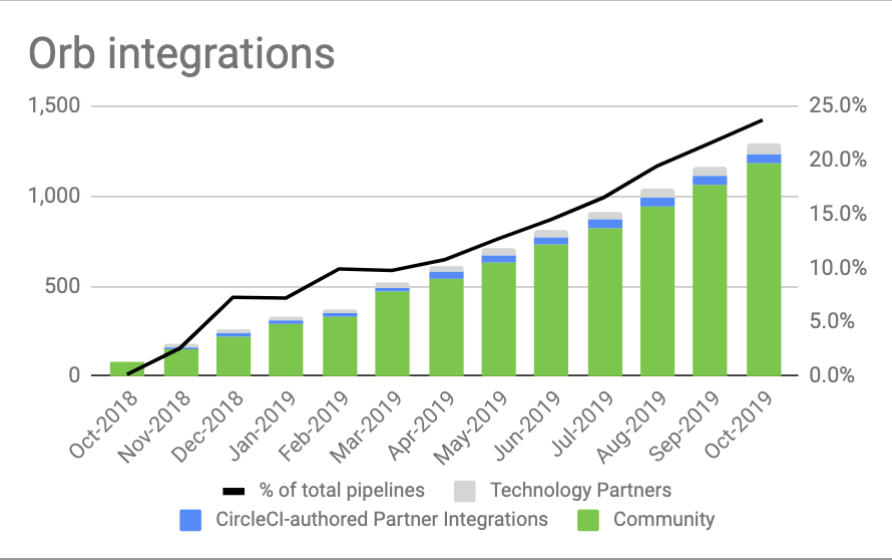
&We&re just seeing a momentum of more and more companies being ready to adopt [managed services like Lambda, ECS and EKS], so this became really the ideal time to do most of the work with the product team at AWS that manages their serverless ecosystem and to add in this capability to leverage that serverless application model and really have this out of the box CI/CD flow ready for users who wanted to start adding these into to Lambda,& CircleCI VP of business development Tom Trahan told me. &I think when Lambda was in its earlier days, a lot of people would use it and they would use it and not necessarily follow the same software patterns and delivery flow that they might have with their traditional software. As they put more and more into Lambda and are really putting a lot more what I would call ‘production quality code& out there to leverage. They realize they do want to have that same software delivery capability and discipline for Lambda as well.&
Trahan stressed that hestill talking about early adopters and companies that started out as cloud-native companies, but these days, this group includes a lot of traditional companies, as well, that are now rapidly going through their own digital transformations.
- Details
- Category: Technology
Read more: CircleCI launches improved AWS support
Write comment (96 Comments)Page 216 of 5614

 8
8